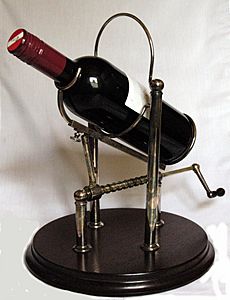Decanter facts for kids
A decanter is a special kind of bottle used to hold liquids, like wine. People use decanters to separate tiny bits of sediment (which are like small particles) from the clear liquid. Decanters often have unique shapes and designs. They are usually made from glass or crystal. Most decanters can hold about the same amount as a standard wine bottle, which is 0.75 litres.
A carafe is similar to a decanter and is also used for serving drinks. However, a carafe does not come with a stopper or lid.
History of Decanters
Decanters have been important in serving wine for a very long time. In the past, wine was stored in large jars called amphoras. Decanters made it easier to bring wine to the table and pour it.
The Ancient Romans were the first to use glass for making these vessels. After the Roman Empire fell, glass became harder to find. So, most decanters were then made from bronze, silver, gold, or earthenware (a type of pottery).
During the Renaissance, people from Venice in Italy started making glass decanters again. They created a new style with a long, thin neck that opened into a wide body. This design helped the wine mix with air, which was thought to improve its taste.
In the 1730s, glass makers in Britain added a stopper to decanters. This stopper helped to limit how much air touched the wine. Since then, the basic design of decanters hasn't changed much.
Even though decanters were first made for wine, they are now also used for other alcoholic drinks. These include cognac or single malt Scotch whisky. Some very special cognacs and whiskies are even sold in their own fancy decanters.
The Decanting Process
Decanting is when you carefully pour liquid from one bottle into a decanter. The main goal is to leave behind any sediment in the original bottle. This way, the "clear" liquid, which is free of these bits, moves into the decanter. It's a bit like racking (a process in winemaking), but it's done right before you serve the drink.
Decanters were often used for older wines that had a lot of sediment. Sediment can form in very old wines or in wines that were not filtered during the winemaking process. Today, many modern wines don't produce much sediment as they age. This means there is less need to decant wine just to remove sediment.
Decanting Cradles
Some special baskets, called decanting cradles, are used to help pour wine. They are usually made of wicker or metal. These cradles let you pour wine from a bottle that has been stored on its side. This helps you avoid stirring up any sediment at the bottom. They are very helpful in restaurants, especially when serving wine during a meal. At home, it's often easier to just stand the bottle upright the day before.
There are also more complex decanting machines. These machines help pour the wine very smoothly, making sure no sediment gets mixed in.
Aerating Wine
Another reason to decant wine is to aerate it, or let it "breathe." When wine mixes with air, it can release more of its good smells and flavors. Decanting is meant to be like swirling wine in a glass. This helps the wine react with oxygen. It is also thought to make some of the stronger parts of the wine, like tannins, feel smoother. It can also help with some unwanted smells in wine.
Many wine experts, like Karen MacNeil, suggest decanting wine to aerate it. This is especially true for wines with strong tannins, such as Barolo, Bordeaux, Cabernet Sauvignon, Port, and Rhône wines. However, they also note that decanting might not be good for more delicate wines like Chianti and Pinot noir.
The idea that decanting helps wine is something that experts still discuss. Some experts, like Émile Peynaud, believe that too much air can actually make the wine lose its good smells. They think that swirling wine in a glass for a short time is better than long exposure in a decanter.
Also, some reports suggest that decanting for a few hours does not really make tannins softer. Tannins become softer during winemaking and oak aging, a process that takes days or weeks. Decanting might just change how you sense certain chemicals in the wine. This can make some people feel like the tannins are softer.
Some wine experts, like Kerin O'Keefe, prefer to let wine change slowly in its original bottle. They suggest simply uncorking the bottle a few hours before serving. Wine makers like Bartolo Mascarello and Franco Biondi Santi also recommend this.
Other experts, such as Jancis Robinson, like decanters for their beauty. They believe that using an elegant, clear glass decanter looks nice. They also think that for most wines, except the very fragile ones, decanting doesn't cause much harm. A decanter can also be used to serve wine without showing its label.
See also
 In Spanish: Decantador para niños
In Spanish: Decantador para niños



